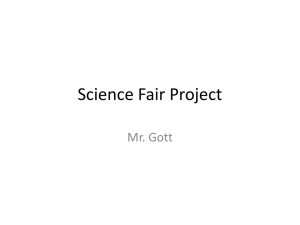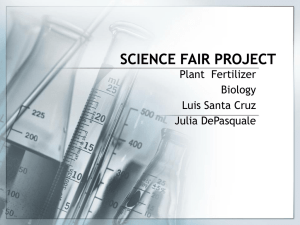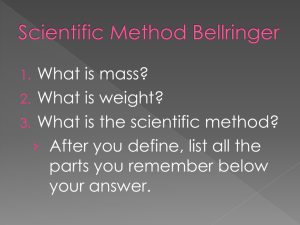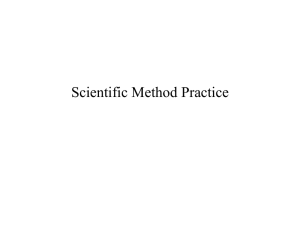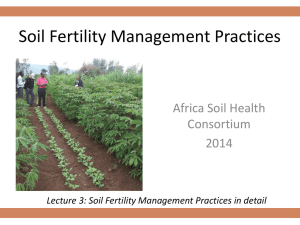Opportunities with phosphorus and threats with cadmium in fertilizers
advertisement
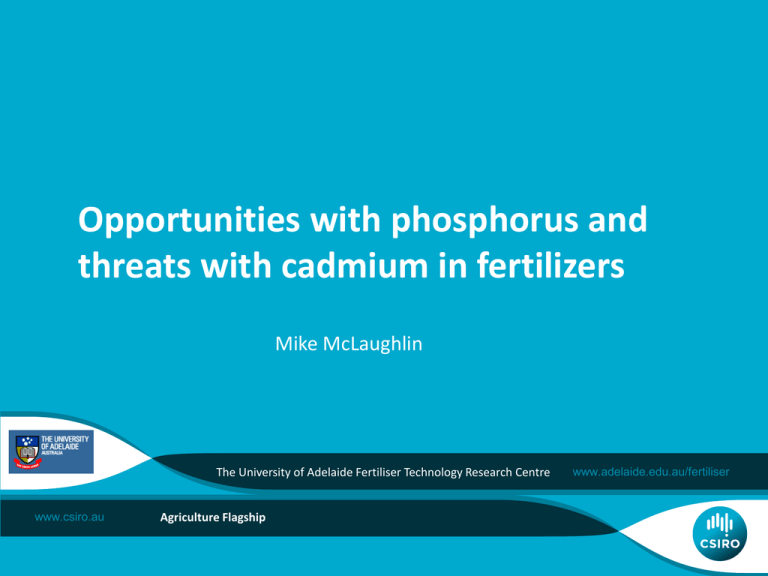
Opportunities with phosphorus and threats with cadmium in fertilizers Mike McLaughlin The University of Adelaide Fertiliser Technology Research Centre www.csiro.au Agriculture Flagship www.adelaide.edu.au/fertiliser Overview Reactions of added fertilizer P in soils The (partial) myth of P fixation Opportunities for P efficiency gains The need for science to develop/validate new P efficiency technologies in agriculture Reactions of added fertilizer Cd in soils Management of fertilizer Cd in agroecosystems Are risks due to fertilizer Cd receding? Summary Reactions of added fertilizer P in soils The fate of added fertilizer P in soil Fertilizer P Plant P Microbial P Soil soln Inorganic P Organic P Reactions of added fertilizer P Hedley and McLaughlin (1992) The (partial) myth of P fixation Crop P responses to P over time Inorganic P Organic P Crop Yield (t/ha) Soil soln P applied (kg/ha) P applied (kg/ha) Fertilizer P requirements over time Maintenance Time Soils with strong P adsorption Al/Fe oxides Source: De Sousa, 2011 Allophane Global coverage of highly sorbing soils www.nrcs.usda.gov Soils with strong P precipitation Source: ISRIC CaCO3 MgCO3 Source: Jorge.Mataix Calcisols Calcarosols Global coverage of calcareous soils Source: FAO Where is P “fixation” a real problem? X X X Source: Vorosmarty CJ, McIntyre PB, et al. (2010) Nature 467(7315), 555-561. Opportunities to improve efficiency Opportunities to improve P efficiency The largest and biggest gains in P efficiency in agriculture are achieved by modifying the application rate If the crop/animal system does not need P to attain the desired production, add less (or no) P (until economic responses to P are predicted) Fertilizer P recommendations Source: http://msue.anr.msu.edu The fate of added fertilizer P in soil ? Fertilizer P (if required) Plant P Inefficiency terms 1. Erosion 2. Leaching/runoff 3. Strong sorption or ppt 4. Occlusion in OM Microbial P Soil soln Inorganic P Organic P Field evidence of efficiency of slow release P Slow release P Source: Water Corporation of Western Australia Yeates JS, Clarke MF (1993) Fertilizer Research 36(2), 141-150. Soluble P Field evidence of cultivar P efficiency Source: Glenn Macdonald and GRDC Field evidence of efficiency of formulations Granular MAP Fluid MAP Source : Bob Holloway Holloway et al. 2001 Plant and Soil 236, 209-219. Field evidence of placement effects Source: bioag.novozymes.com Improving P efficiency by releasing “fixed” P/reducing sorption The scorecard Placement of P e.g. banding Cultivation to mineralise organic P Changing fertilizer formulation - fluids Changing fertilizer formulation – slow release (for leaching) New fertilizer formulations - chelates, slow release (to reduce sorption) Inoculants/biostimulants to release “fixed” P ? ? Inoculants/biostimulants to release stable organic P ? The need for science to validate new P efficiency technologies Peak “technology” release times Source: GSA New P efficiency technologies Data compilation of response to the polymer in trials Chien SH, et al. (2014). Agronomy Journal 106(2), 423-430. Reactions of added fertilizer Cd in soils The fate of added Cd in soil Food regulations drive Cd management Soil Cd in Europe Management of fertilizer Cd in soils Factors affecting Cd concentration of crops weather Crop Genetics Soil characteristics Tillage and agronomic management Soil Cd concentration Irrigation and water management Crop Rotation Fertilizer management Are fertilizer Cd risks receding? Predicted change in soil Cd over 100 years in 540 potential European scenarios: soil pH is the main driver Average scenario: 15% depletion • Reduced atmospheric deposition of Cd • Large reductions in use of P fertilizers in EU Six L, Smolders E (2014) Future trends in soil cadmium concentration under current cadmium fluxes to European agricultural soils. Science of the Total Environment 485, 319-328. Cadmium in European crops now declining Kirchmann H, Mattsson L, Eriksson J (2009) Trace element concentration in wheat grain: results from the Swedish long-term soil fertility experiments and national monitoring program. Environmental Geochemistry and Health 31(5), 561-571. Cadmium in Australian agroecosystems • Low geogenic soil Cd • Minimal atmospheric Cd deposition • History of low P additions in fertilizer from island rocks having higher Cd • Generally sandy soils, low organic matter, high salinity Soil Cd closely linked to fertilizer addition 0.8 y = 0.0008x + 0.0183 R2 = 0.53 EDTA-extractable Cd (mg/kg) 0.7 0.6 0.5 0.4 0.3 0.2 0.1 0 0 200 400 600 800 H2SO4-extractable P (mg/kg) Merry, R. H., (1992) CSIRO Report to MRC/FIFA, Australia. 1000 Predicting crop Cd concentrations over time EU limit for canola FSANZ limits for cereals Vries W de, McLaughlin MJ (2013). Sci. Tot. Environ. 461-462, 240-257. Predicting crop Cd concentrations over time FSANZ limit • Reduced input of fertilizer Cd (lower Cd ferts) • Reduced inputs of P Vries W de, McLaughlin MJ (2013). Sci. Tot. Environ. 461-462, 240-257. “Critical” Cd concentrations in fertilizers Calculated critical loads for Cd in soil and related critical Cd/P ratios in P fertilizers Land use Soil type CLOCd P input Cd/Pcrit g ha-1 yr-1 kg ha-1 yr-1 mg Cd kg P-1 Dry land Calcareous clay 0.38 20 19 cereals Sand 2.85 20 143 Sugarcane Heavy clay 5.91 50 118 rotation Loam 18.13 50 363 Dairy Organic heavy clay 1.37 40 34 production Loam 2.96 40 74 Intensive Heavy clay 7.16 100 72 annual Loam 21.20 100 212 horticulture Current average fertilizer quality used in Australia = ~60 mg Cd/kg P Vries W de, McLaughlin MJ (2013). Sci. Tot. Environ. 461-462, 240-257. Summary Efficiency of P fertilizer use may not be as low as you think – over-application is often the key cause Some soils do not need novel P “enhancers” Work on improving P efficiency is most critical for developing countries with high-sorption soils having had poor P fertilizer inputs A combination of plant, fertilizer formulation/ management and soil factors can be used to improve P efficiency New “P efficiency” technologies need proper mechanistic and field evaluation Summary Cadmium is of concern in fertilizers, but is not as big as hazard for P use as previously thought Cadmium build-up in soils is much lower than previously predicted due to Lower atmospheric Cd inputs (in Europe) Lower fertilizer P (Cd) inputs (as soils become “P fertile”) Greater control of Cd quality of other soil amendments In the short term, agronomic management can effectively control food chain Cd contamination More data and modelling needed for developing countries Acknowledgements Thank you The University of Adelaide Fertiliser Technology Research Centre Agriculture Flagship www.adelaide.edu.au/fertiliser

